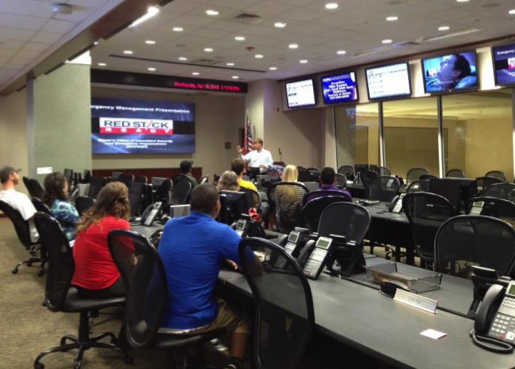Louisiana has a storied history of hurricanes tropical storms, and heavy rainfall events that have had dire impacts in the coastal communities, where much of the state’s population and infrastructure reside. A Coastal Resilience Center of Excellence (CRC) project, based at Louisiana State University (LSU), aims to formalize teaching students about management of disaster events like these and the science behind those disasters.

Dr. Barry Keim, a Professor in the Louisiana State University Department of Geography and Anthropology, leads an education project called “LSU’s Disaster Science and Management Program.” Dr. Keim, who is also the Louisiana State Climatologist, will focus on institutionalizing an existing education program by making it an integral part of the Geography degree program. Dr. Alan W. Black, an Assistant Professor of Research in the Department of Geography & Anthropology, also manages and teaches in the program.
As an end result, both bachelor’s of arts and bachelor’s of science degrees will include a concentration from the Disaster Science and Management Program (DSM), and the courses will be offered as a minor to students with majors in other departments. For the first eight years of its existence, the program had no home department.
Dr. Keim also hopes to enhance an existing relationship with Baton Rouge Community College (BRCC), which offers an Emergency Management program. That relationship would include easing credit transfers for students entering LSU from BRCC to continue the BA or BS degree.
“Louisiana’s propensity for natural disasters – including hurricanes Katrina, Rita, Gustav, Ike and Isaac – demonstrates a clear need for a robust disaster science and management program in the region,” Dr. Keim said. “We intend to build a curriculum that is a mix of on-campus and online courses, and will build on the past successes of the student internship program.”
The program officially commenced as part of the Geography Department in the 2016 fall semester. Classes include “Hazards, Disasters and the Environment,” “Fundamentals in Emergency Management” and “Hazard Risk Reduction,” as well as technique courses in the Geographic Information System (GIS) and remote sensing. An average of more than 140 students have been enrolled in the program over the last four semesters.
Coursework covers natural coastal disasters, resilience and geomorphology (the study of the earth’s surface features and their relationship to geological structures). It focuses on different types of disaster elements such as hurricanes, storm surge, tornadoes and rainfall, as well as use of mapping technology in plotting disaster impacts. Students are taught not only about hazards and disasters, but also how to reduce the risk of those hazards.

Emergency Preparedness as part of Dr. Barry Keim’s project. Photo submitted.
“We want to make the concentration available to students regardless of which path they want to take – more of a social science path or more of a hard science path,” Dr. Keim said. “Ultimately, what we’re trying to train students for is the Homeland Security enterprise. We want students to come out of this with some tools they can actually use, to have something in their toolbox to sell to employers.
“We want them to take at least one course in computer cartography or GIS. The more types of skills they have, the more marketable they’ll be.”
Real-world experiences
In addition the classroom experience, students have been placed at internships across a wide range of organizations, from the American Red Cross and the Louisiana Governor’s Office of Homeland Security and Emergency Preparedness (LA GOHSEP) to local groups such as the East Baton Rogue Parish Office of Emergency Preparedness and Ascension Parish Emergency Management. LA GOHSEP and parish emergency management and law enforcement groups have hired graduates of the program as well.
“This is where the rubber meets the road – when students take their book knowledge and actually apply it in the real world,” Dr. Keim said. “They also learn the value of the techniques they’ve learned as they apply GIS technology to actual problems.”
The program integrates research and education through CRC programs as well. An LSU graduate student participated in the Summer Research Experience program, spending the summer of 2016 with Principal Investigator Dr. Don Resio at the University of North Florida studying storm surge modeling. The LSU program will host Dr. Resio for a return lecture this year through the RETALK program. This summer, another LSU graduate student spent most of the summer working with Brian Blanton at the University of North Carolina at Chapel Hill learning the nuances of the Advanced Circulation (ADCIRC) Model for storm surge modeling.
“Louisiana’s propensity for natural disasters – including hurricanes Katrina, Rita, Gustav, Ike and Isaac – demonstrates a clear need for a robust disaster science and management program in the region.”
The program has also established potential partnerships at the Center for Homeland Defense and Security at Naval Postgraduate School National Center for Biomedical Research and Training at LSU. Other partners include the National Oceanic and Atmospheric Administration’s Southern Climate Impacts Planning Program (SCIPP). SCIPP is a research initiative that focuses on climate extremes and involves stakeholder input. This research program intersects well with the educational DSM program by uniting teaching and research projects, Dr. Keim said.
“We are training the next generation of emergency managers,” he said. “And we are providing them with a firm geographical foundation to integrate humans with the natural and built environment.”
